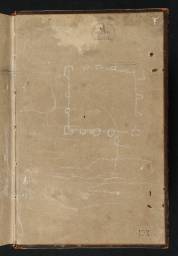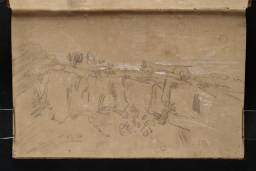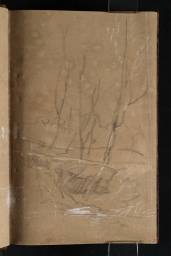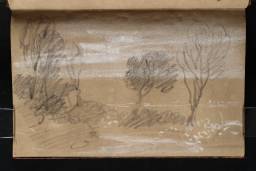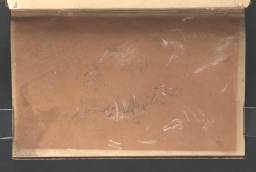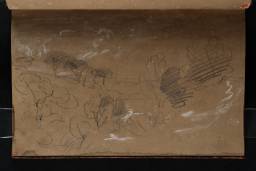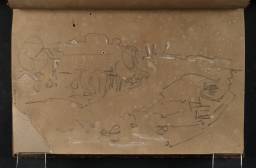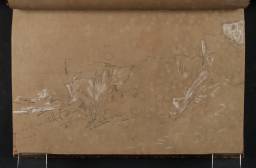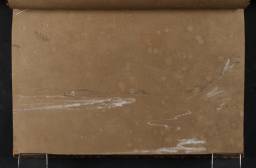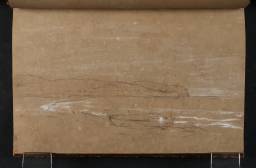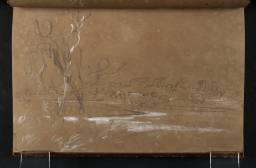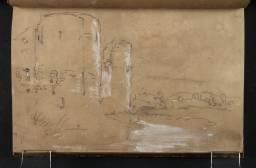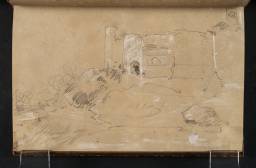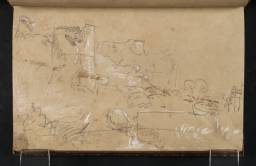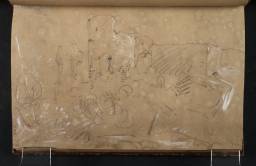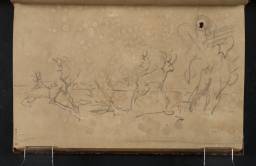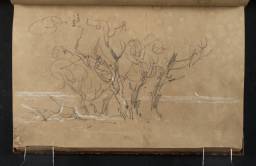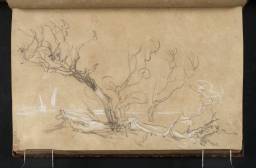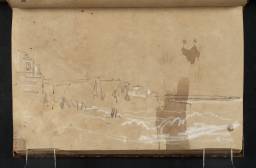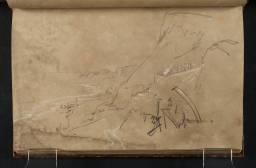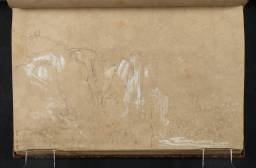Turner Bequest XCI
Sketchbook, bound in marbled calf, with gold-tooled spine and foredges, and two clasps removed
97 leaves of cream wove paper, prepared with a buff wash
Approximate page size 201 x 128 mm
Made by William Balston and Finch and Thomas Robert Hollingworth at Turkey Mill, Maidstone, Kent
Watermarked ‘1794 | J. WHATMAN’
Inscribed by Turner in ink ‘23 Coast. Lewes. Hurstmonceux | Pevensey G[?uestling]. Winchelsea’ on a label on the spine (D40798)
Endorsed by the Executors of the Turner Bequest in ink ‘No.155’ and signed in ink ‘George Jones’ and in pencil by Charles Lock Eastlake and John Prescott Knight ‘C.L.E.’ and ‘JPK’ inside back cover
97 leaves of cream wove paper, prepared with a buff wash
Approximate page size 201 x 128 mm
Made by William Balston and Finch and Thomas Robert Hollingworth at Turkey Mill, Maidstone, Kent
Watermarked ‘1794 | J. WHATMAN’
Inscribed by Turner in ink ‘23 Coast. Lewes. Hurstmonceux | Pevensey G[?uestling]. Winchelsea’ on a label on the spine (D40798)
Endorsed by the Executors of the Turner Bequest in ink ‘No.155’ and signed in ink ‘George Jones’ and in pencil by Charles Lock Eastlake and John Prescott Knight ‘C.L.E.’ and ‘JPK’ inside back cover
Accepted by the nation as part of the Turner Bequest 1856
Exhibition history
References
This sketchbook contains views in Sussex, mainly in the east of the county. There are also views of Lewes further to the west, as Turner acknowledged when naming the book.
Although most subjects in the book are easily identified, it is in some respects mysterious. The ‘G’ in Turner’s title might indicate Guestling near Hastings and noting that Evelina, Turner’s supposed natural daughter by Sarah Danby, had been baptised there in 1801, Anthony Bailey wonders if Turner is ‘suppressing some of the evidence, as if he didn’t dare spell out the full name for fear of giving something away, even to himself’.1 Guestling is mentioned in the Hastings sketchbook (Tate D07751; Turner Bequest CXI 99) at much the same time as Sarah gave birth to another daughter, Georgiana. This might suggest that Turner had personal as well as professional business in Sussex when an order from John Fuller of Rosehill (now Brightling) Park for local views brought him there in 1810.
With a similar Sussex sketchbook (Tate D05717–D05765; D40631; D40633; D40660 Turner Bequest XCII), this one was dated 1804–6 by Finberg and circa 1806–7 by Eric Shanes2 who notes that it ‘seems more certain’ that Turner toured East Sussex around that year.3 More recently Andrew Kennedy has stated that Turner visited the area between 1805 and 1807.4 On stylistic grounds, the use of black and white on paper prepared with coloured washes might support a relatively early date for both books. However, it is hard to separate Turner’s attention to monuments like Pevensey, Herstmonceux and Bodiam Castles and Battle Abbey from his later work for Fuller, which included these subjects. Indeed Turner’s visit to Rosehill in 1810 is described by Shanes as the artist’s ‘first proper stay’ in East Sussex.5 Apart from a brief visit to Petworth in West Sussex in 1809, there seems no certain evidence of a visit to the county in the mid to later years of the decade and suggestions of one seem to rest on Finberg’s dating of the sketchbook. On the other hand again, Turner’s visit to his friend William Frederick Wells at Knockholt, Kent, in late summer 1806 could easily have been extended by a trip to the coast.
Writing of this and the similar Sussex sketchbook, which looks contemporary, Gerald Wilkinson observed that ‘the reason for the artist’s visit to the Sussex coast is unknown, and the character of the drawings suggests a holiday rather than a commission’.6 Perhaps, but during Turner’s visit in 1806, Wells suggested the idea of landscape compositions that became the Liber Studiorum and Turner’s tonal approach in these sketchbooks might be related to ideas for reproduction in black and white. A Liber subject, Martello Towers, near Bexhill, Sussex has its origin here, in a drawing of Pevensey Bay on folio 11 (D05628). If, as seems possible, the water wheel drawn on folio 62 (D05679) is connected with the Liber plate of Pembury Mill, published in 1808, this could confirm that the sketchbook was in use around 1806/7. The most direct route from Knockholt via Sevenoaks and Tonbridge to Battle (now the A21) passes through Pembury. Further Liber subjects originate in the Sussex book. The present book contains architectural subjects that Turner depicted for Fuller: Pevensey Castle, folios 13–21 (D05630–D05638); Herstmonceux Castle, folios 39–44 (D05656–D05661); Bodiam Castle, folios 67–77 (D05684–D05694); and Battle Abbey, folios 45–54 (D05662–D05671). But while pencil drawings in other Sussex sketchbooks tend to provide detail and were used more directly for Fuller’s watercolours, the sketches here present them in terms of tonal contrast and atmosphere. It seems at least possible that rather than all being made on a separate earlier tour, some could be contemporary and made to address the subjects in a different way. To allow for this, the catalogue extends the date-range to circa 1810.
Technical notes
How to cite
David Blayney Brown, ‘Herstmonceux and Pevensey sketchbook c.1806–10’, sketchbook, March 2011, in David Blayney Brown (ed.), J.M.W. Turner: Sketchbooks, Drawings and Watercolours, Tate Research Publication, December 2012, https://www

